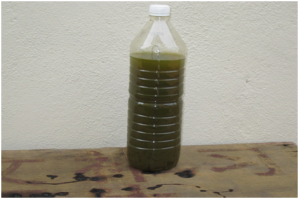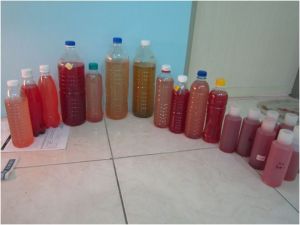Phototropic bacteria – purple non sulfur bacteria
When people talking of photosynthetic bacteria (Photosynthetic bacteria, referred to as PSB), for those who are familiar with agriculture and aquaculture farming, the first thought come to mind probably is one of the microbes found in the Effective Microbes (EM) community.
Reasons why PSB became my microbes of interest because they are believe to be the earliest ever microbes that exist in this earth, supporting and balancing the ecology living of every single living organism!!
What is Photosynthetic bacteria?
Photosynthetic bacteria ( accurately purple bacteria in this context), is gram negative, prokaryotic bacteria, widely distributed in the paddy fields, rivers, oceans and soil in a large class of bacteria. They are single celled microscopic organisms that play a vital role in sustaining the tree of life. This tiny organism loves to live in aquatic environments like the bottom of lakes and the colorful corals under the sea, using sunlight as their source of energy.
Well, ‘Photosynthetic bacteria’ is a big term of genus classification, just as human, we have Asian, European, African..Ok, to make it simple, phototropic bacteria generally (up to date) were divided into 4 groups based on it’s
a) Photosynthetic pigment system, b) the ability to use sulfur as electron donor
1) Rhodospirillaceae (Rhodospirillaceae or purple non-sulfur bacteria Division)
2) Chromatiaceae (red sulfur bacteria Branch)
3) Chlorobiaceae (green sulfur bacteria Branch)
4) Chloroflexaceae (gliding filamentous green sulfur bacteria Branch)

- My experiment to optimize the medium for Rhodopseudomonas palustris, (1,2) Rhodobacter Sphaeroides (3,4). Generally, the reddish the colour change, the higher the concentration cfu/ml.
- The genus of of interested- Rhodospirillaceae (Purple non sulfur bacteria), currently are getting more and more attention of scientist, specifically for its incredible ability in waste water treatment and aquaculture farming. The spesies of popular would be be Rhodopseudomonas palustris, Rubrivivax gelatinosa, Rhodobacter capsulata, R. spaheroides, Phaeospirillum fulvum. ( Those spesies that live inside EM). The common features are having flagellar movement, does not generate the bubbles, the cells do not accumulate sulfide.Why Purple Non sulfur bacteria (PNSB)?First of all, these bacteria possess a diversified metabolism, which meanIn order to survice, they can adapt themselves to become: phototropic, photoheterotropic, chemotropic and chemoheterotrophic. Also, these bacteria can grow with or without oxygen, grow in the sunlight, inorganic compounds, or organic compounds for energy; it can acquire carbon source from either carbon dioxide fixation or complicated organic compounds. Such as amazing superior microbes!!Well, I understood that the above statement looks confusing especially for those still new in microbiology, but for sure is another big and great topic. I guess I probably will create another new post purposely to cover the topics.
Nowadays, using PNSB as probiotics is common practice in many fish or shellfish hatcheries and farms in China and Taiwan. Instead of using homemade PNSB products, many farmers today are using concentrated and encapsulated commercial photosynthetic bacterial products. Many commercial photosynthetic bacterial products are labeled as either single or multiple species at concentrations higher than 109 ml−1, and are often combined with growth promoters or conditioners, and are claimed to have multifunctional effects such as improvement of water quality, enhancement of growth rate and prevention of disease.
Phototropic bacteria as a high-quality protein feed
Do you know that phototropic bacteria are served as a nutritious food for larva stages of fish?
It is becoming increasingly evident that the development of low-cost, high-quality protein feed is crucial for the future success of aquaculture industry. As single cell proteins (SCP), microalgae have been used as an essential food for the larval stages of fish and shellfish and yeasts have been considered as algal substitute for several species of filter feeders, but the industrial production of SCP from microalgae and yeasts has not been extensive so far.
Compared to microalgae and yeasts, photosynthetic bacteria have some advantages as a diet for aquaculture. They are available as a by-product from agricultural wastes , have more digestible bacterial cell wall, and are rich in protein, carotenoids, biological cofactors, and vitamins.
It was reported that addition of photosynthetic bacteria as food source stimulated the growth of zooplankton much more than green algae did, and are very useful for growth of brine shrimp (Kobayashi, 1995). Further, photosynthetic bacteria were also identified as prey material for that fish fry soon after hatching, resulting in an increase in weight and survival rate of more than twofold within 2–4 weeks after hatching. The rate of survival increased markedly and almost no mortality was observed when 0.1% live cells of photosynthetic bacteria were added to the formula feed given to the fry of crucian crap soon after hatching.
It was also reported that prawn culture tanks were frequently affected by gill disease causing great economic damage, but this was completely prevented by supplementing the tanks with photosynthetic bacteria. Such effects have also been displayed in suppression of virus diseases noted on others including shellfish (Okamoto et al., 1988; Hirotai et al., 1991).


Hi. Please contact me to discuss purple nonsulfur bacteria.
Yes, Friend, anything i can help u?
Hi Ken,
Im an environmental science teacher and I’m interested in doing experiments with the purple sulfur bacteria since I got to read about it since 2008. Could you give me some information on where to buy such lovely cultures, such as the Rhodopseudomonas?
Good job by the way with your experiments, I love the things you are doing there in your lab.
Neil
Ya, where are u from?
I dont really buy.
The PSB i isolated in my country, at bottom of pond
Which can resist 36ppm salinity
how to isolate PNSB
pls let us know
find the answer here
https://www.facebook.com/ken.microbes
hi, how to isolate pnsb pls mail im from india
how u think?
can u tell me how to isolate bacillus subtilis
U come to Malaysia, i teach u
how to grow PNSB ? What kind of food for PNSB?
TNX
u will see the answer on here
https://www.facebook.com/ken.microbes